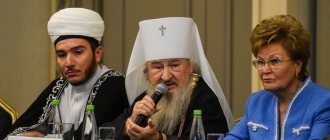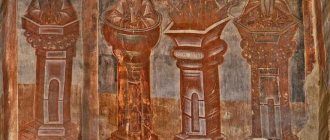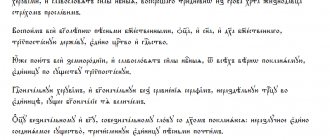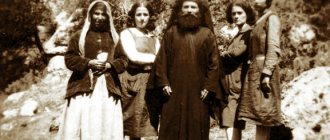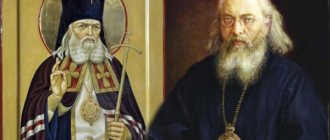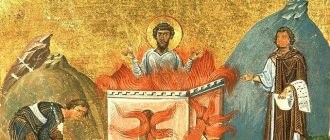Childhood and youth
The name of the hermit Theophan the Recluse in the world is Georgy Govorov. The boy was born on January 10, 1815 in the Oryol province. His father, Orthodox priest Vasily Govorov, served in the Vladimir Church. Mother Tatyana Govorova came from a priestly family.
Feofan the Recluse
It was easy to predict what the biography of their child would be like. The parents raised their son, introducing him to the Gospel, giving instructions in accordance with the commandments, and talking about the importance of a person’s spiritual life. From a young age, the boy participated in Orthodox rites, serving at the altar of the temple where his father worked.
In 1823, George was sent to a religious school. The boy showed diligence and interest in knowledge. After 6 years, he successfully completed his studies and entered the Oryol Theological Seminary. He liked to study and read books. The seminarian, at his own request, re-took an educational course in philosophy.
Portrait of Theophan the Recluse
Having received the blessing of the Olovsky Bishop, Georgy Govorov went to the Kyiv Theological Academy. For his demonstrated success, the student was sent there to continue his education at the expense of the state.
With diligence and interest, the young man mastered new disciplines and showed himself as a creative person. He began to write notes and small theological works. George loved to retire to quiet corners of the Kiev-Pechersk monastery and pray. The theologian subsequently considered this period one of the most reverent in his life. After all, it was then that he realized that he wanted to connect his life with the fulfillment of his monastic duty.
Kyiv Theological Academy
In the 30-40s of the 19th century, the Kiev Theological Academy flourished. A favorable moral environment reigned within the walls of the academy and talented teachers taught. Filaret (Amphitheaters), Metropolitan of Kiev, paid a lot of attention to the academy. The saint especially monitored the spiritual state of the students.
Kiev Theological Academy
Rector, Archimandrite Innokenty (Borisov), lectured on theological sciences. The rector was a gifted preacher, and he taught his students to freely express their thoughts and knew how to captivate them with the subject.
Most of all Govorov fell in love with the inspector of the academy, teacher of dogmatic theology, Archimandrite Dimitry (Muretov). The future saint considered him the smartest, most educated and “best in life” among his contemporaries.
Professor of eloquence Yakov Kuzmich Amphitheatrov also had a huge influence on his students. He taught the young men to speak simply, clearly and with conviction.
It was within the walls of the academy that the future saint learned to express his thoughts in writing and fell in love with writing. His classmate, Metropolitan Macarius (Bulgakov), recalled that Georgy Govorov wrote better than anyone, but was ashamed to read his works loudly.
Until the end of his life, Saint Philaret recalled with deep reverence the Kiev Pechersk Lavra, like a fragment of Heaven on mortal earth: “The Kiev Lavra is an unearthly abode.”
During his years of study in Kyiv, Georgy Govorov lost his parents. First the mother died, then the father. This influenced the choice of the monastic path. In the winter of 1841, George took monastic vows with the name Theophanes in honor of the Venerable Theophanes the Confessor. In the spring of the same year, the monk was ordained a hierodeacon, and in the summer - a hieromonk. In 1841, Hieromonk Feofan received a master's degree and graduated from the academy among the best.
The graduate received the most important advice from Elder Parthenius: “one thing is most necessary: to pray and pray unceasingly with your mind in your heart to God.” The saint followed this advice all his life.
Service
In 1840, Govorov turned to the leadership of the academy with a request to become a monk. The ceremony was held in the winter of 1841 under the leadership of His Eminence Father Jeremiah, rector of the educational institution. So Georgy Govorov received the name Feofan in honor of Saint Theophan the Confessor. In the same year, the monk received the rank of hierodeacon and by the summer he was ordained a hieromonk. The clergyman graduated from the Kyiv Academy with the status of a master, having defended his dissertation.
Icons of Theophan the Recluse
After training, the theologian was appointed rector of the Kiev-Sophia Theological School, where, in addition to teaching Latin, he studied the lives and biographies of the saints of the Russian Orthodox Church. In 1842, Father Feofan became an inspector of the Novgorod seminary. There he taught logic and psychology, bringing to the consciousness of his students the idea of the need for godly activities. According to the teacher, dry science should not dominate a person’s life, leaving no room for the empirical.
In 1844, Feofan was appointed teacher at the St. Petersburg Academy. The clergyman worked at the department of moral and pastoral theology, and already in 1845 he was promoted to inspector of an educational institution. After some time, the theologian became a member of the Russian Spiritual Mission in Jerusalem.
Theophan the Recluse before the crucifixion
As part of the group, he arrived in Palestine and then in the Holy Land. The monk continued to study French and Greek, became familiar with the original manuscripts, and became imbued with the basics of other faiths: Gregorianism, Catholicism, Lutheranism.
The beginning of the Crimean War stopped the activities of the Russian Mission in Jerusalem. In 1853, its participants were called back to Russia. In 1855, Father Feofan was ordained archimandrite, and he again began teaching at the Theological Academy in St. Petersburg. After a couple of months, the theologian was transferred to the post of rector of the Olonets Seminary. The monk led the educational institution and supervised the construction work on its reconstruction.
Monastery of Theophan the Recluse in the Vyshenskaya Hermitage
In 1856, Father Theophan went to Constantinople to serve as rector of the Russian Embassy Church. A year later, having won respect and favor, the educated and wise theologian returned to Russia, where he took the post of rector of the St. Petersburg Theological Academy. At the same time, he participated in the publication of a magazine called Christian Reading.
In 1859, the archimandrite was transferred to the rank of bishop of Tambov and Shatsk. Educational institutions and schools appeared in his dioceses. Father Theophan did not abandon his educational work in any of his places of service. But more and more often he thought about solitude and seclusion.
Books by Theophan the Recluse
In 1863, the bishop was transferred to the see in the city of Vladimir-on-Klyazma, where he also founded a diocesan publication and sought to increase the number of schools and colleges. Over time, the service ceased to bring satisfaction to Father Theophan, and he turned to the Synod with a request to be removed from business.
At the request of the monk, he was appointed rector of the Vyshenskaya Hermitage. Thus began the clergyman’s seclusion. He rarely had guests or visitors. In his cells, the monk organized a house church, where he served the Divine Liturgy. Theophan the Recluse spent his days in prayer, and also carried out theological work, answering letters from people who turned to him for help, advice and guidance.
Vladimir diocese
There were many schismatics in these places, and Theophan the Recluse traveled to schismatic settlements, preaching and revealing the errors of the schism. For these works the saint was awarded the Order of Anna, 1st degree.
Most of all, Vladyka sought to engage in spiritual writing in order to serve the salvation of people in this way. The vain episcopal position brought much grief to his loving heart. After 3 years of zealous service, His Grace Theophan submitted a request for retirement to the Vyshenskaya hermitage. The authorities did not want to let Vladyka go for a long time, but then they fulfilled his request.
Personal life
The private life of Father Feofan turned out to be as pleasing to God as his activities for the benefit of the Russian Church. Orientation towards the principles of asceticism in everything implied contentment with little. In addition to scientific and literary work, the monk was engaged in manual labor.
Feofan the Recluse
He whiled away his leisure time at a carpentry or lathe, making wooden crafts. On fine days I walked in the fresh air. Nature delighted the clergyman. In her he saw the crown of creation. Father Theophan had a telescope at his disposal, through which the theologian observed the heavenly bodies. Theophan the Recluse also painted icons and sewed clothes for himself.
High positions and rank did not affect Father Feofan’s attitude towards others. He was democratic and did not allow unnecessary things in his sayings and statements. The man behaved with dignity, but not arrogance. The monk was trusted and respected by his subordinates for his delicacy, nobility and wisdom.
Reclusion
In 1872, the saint actually began to lead the life of a recluse. He locked himself in a separate room. The circle of his visitors was limited to an extremely small number of people. In his cells, he set up a small house church, and he himself served the Divine Liturgy in it: at first - on Sundays and holidays, and in the last years of his earthly life - every day.
In addition to prayer, he devoted a significant part of his daily routine to reading, analyzing correspondence and composing reply messages, and theological works. At the same time, guided by ascetic instructions, he paid a lot of attention to physical labor: he was engaged in icon painting, wood carving, and sewing clothes for himself.
On January 6, 1894, the saint quietly departed to the Lord. The funeral service for the archpastor took place on January 11 in front of a huge crowd of people. The bishop's body was buried in the Vyshenskaya Hermitage, in the Kazan Cathedral.
Death
Theophan the Recluse died in the monastery in 1894. Cardiovascular diseases, rheumatism and neuralgia caused him pain and discomfort. Progressive cataracts led to the fact that in 1888 the clergyman became blind in his right eye. The cause of death was old age and related illnesses.
Sarcophagus of Theophan the Recluse
The monk's funeral service took place on January 11. A large number of people came to say goodbye to Father Feofan. The burial of the clergyman was in the Kazan Cathedral of the Vyshenskaya Hermitage.
The relics of Theophan the Recluse were transferred, and today they are kept in the Church of St. Sergius of Radonezh, where an akathist is read in honor of the deceased. Thanks to modern technologies, any Internet user can view the photo of the clergyman.
Day of Theophan the Recluse
According to the new style, the saint's feast day is celebrated on January 23. During this period, the following events are traditionally held:
- Orthodox people from all over the world come to churches to see the relics of the saint and turn to him with prayers;
- divine services are held: church ministers perform akathists and chants in honor of the great theologian;
- famous scientists and philosophers revere the great teacher for his works and contribution to the development of Orthodox culture.
The best article for you, go to: The Life of St. Silouan of Athos, what it helps with and what they pray for
Bibliography
- 1859 — Collection of sermons “The Word of Archimandrite Theophan”
- 1861 — “Words to the Tambov flock”
- 1868 -1869 — Book of lectures “The Path to Salvation”
- 1887 - “Thoughts for Every Day of the Year”
- 1891 - “Outline of Christian Moral Teaching”
- 1891 - “Psalm one hundred and eighteenth, interpreted by Bishop Theophan”
- 1892 — “Letters to various persons on various subjects of faith and life”
- 1898 - “Letters on the Christian Life”
The letters and sermons of Theophan the Recluse are combined into collections that represent the monk’s legacy. Books published decades after his death:
- "The door of repentance. Words and Sermons"
- "Illness and Death"
- "Fighting Passions"
Consolation of a mother who has lost her children
“You have focused your attention entirely on the sad side of the matter, and do not see God’s care for you?! And she really is. Can't you touch it?! That's what she is. It is not tangible in the present, but visible later. Resurrect your faith, and consolation will flow from there like a river.
I'll tell you a case. In S.P.B. one big lady lost three children, smart, cute, well-behaved - especially the eldest was in a reverent mood and knew how to pray. Is there not enough grief here?! But this is not enough. A little later, she lost her husband, and that was not enough: she was left with nothing.
There was no limit to my grief. She took courage, indulging in prayers according to the will of God. But the grief gnawed. Finally, the Lord had mercy and sent a dream as a consolation. She sees her husband in a semi-dark state. He asks how are you? “Nothing,” he says, the Lord is merciful. But we must be patient until this darkness passes.” - What about children? “The children are there, pointing to the sky,” he said. “And Masha?” (this is the oldest, about 5 years old). “God sends Masha to earth to console those who mourn.
Since then the grief has passed. So, have you seen where the children are? And yours are there. – Would they have gotten there if they had remained alive? Who knows. And now it's true. So what better things for you parents to wish for your children?!
And settle in this thought that the fate of your children has worked out in the best possible way. And stop mourning.
After all, you yourself will die. There will be someone to meet you, and perhaps protect you.”
Quotes
“You can live a whole century with one Gospel or New Testament and read everything. Read it a hundred times, and everything will still be unread.”
“There are people who think that they are expanding the circle of freedom by not limiting their desires, but who in reality are like monkeys who willfully entangle themselves in a net.”
“When self-praise comes, then collect everything from your previous life that, in good conscience, you cannot praise, and suppress rebellious thoughts with it.”
“The enemy usually runs up and says: don’t let go, otherwise they’ll peck you. He's lying. The best protection from being pecked is humble compliance.”
"Don't say, 'I can't.' This word is not Christian. Christian word: “I can do everything.” But not in itself, but about the Lord who strengthens us.”
Why didn't Christ's disciples fast?
Vyshensky Assumption Monastery.
Magazine photo from the late 19th century “They asked the Lord: why don’t His disciples fast? He answered: because the time has not yet come for them. Then, in parable speech, he showed that, in general,
the rigor of external asceticism must correspond to the renewal of the internal forces of the spirit.
First, kindle the spirit of jealousy, and then impose severity on yourself, for in this case there is a new inner strength in you that can withstand them with benefit. If, without this zeal, you take up rigor, being carried away either only by the example of others, or by the show of asceticism, then this will not be beneficial.
You will hold on to this strictness for a little longer, and then you will weaken and give up. And you will be even worse than before.
Severity without inner spirit is the same as a patch of raw linen on old clothes, or new wine in old wineskins.
The patch will fall off, and the hole will become even larger, and the wine will break through the skin, and will disappear on its own, making the skin worthless.
This, however, does not mean that strictness is not suitable, but only that it is instilled that it is necessary to start them in order. It is necessary to make sure that their needs come from within, so that they satisfy the heart, and do not only oppress from the outside, like oppression.”
